 Loading... Please wait...
Loading... Please wait...
Experience More Standing Desk Benefits with Active Standing Tools

Research shows health and productivity benefits from the ergonomics of stand up desks. Accessories optimize the practice and avoid the downside of standing up.
The sit-stand desk is past the point of being a novelty. In both corporate and home office settings, the findings of scientific study (including those reported in the Journal of Physical Activity and Health tell us that extended sitting is associated with an increased risk for cancer, weight gain, metabolic diseases, and greater fatigue and back discomfort. But the ergonomics of standing desks are complicated.
Companies are adopting them on a general idea that healthy employees are productive employees. This is not mere intuition: a study of 167 call center employees in Texas (conducted by the Texas A&M University’s Health Science Center School of Public Health) found that people in the stand-capable group had a remarkable 53 percent greater success rate after six months of study as compared to seated-only employees.
The gurus of workplace health are firmly behind the trend. The International WELL Building Institute, which promotes healthy workplaces, encourages different versions of height-adjustable desks in their evaluation process. Companies that wish to achieve the WELL certification need to provide at least 60% of their employees with some type of standing desk, be it adjustable height desks or height adjustment mechanisms on traditional desks.
Just standing doesn’t solve everything
Healthy living advice has an unfortunate history of false binary choices, and office ergonomics can easily fall into that trap. “Sitting is the new smoking, so get a standup desk,” we hear. This is a little like the “dietary fat is bad for you” notion of nutrition 20 years ago. We’ve since learned that there are in fact “good fats” that need to be consumed in balance and moderation for long-term health.
Sitting vs. standing while working is in a similar place. This is not an either or choice. There are good ways to stand and bad ways to sit and the opposite, good sitting and bad standing. And it helps to mix it up.
Poor posture and stagnant positioning (i.e., not moving) are what matter, and that can happen in both the sitting and standing positions. Some users of standing desks experience new musculoskeletal or circulation problems, such as pain, swelling or stiffness in the back, legs, feet and shoulders. These symptoms are due in part to a restricted blood flow to muscles that are “loaded,” meaning, unless the individual shifts his or her weight around to different muscles a single set of those muscles are constantly engaged and deprived of sufficient blood flow.
The whole workstation matters in ergonomics
So how can that be avoided? A frequent shifting of body weight is beneficial to the feet, legs, back, shoulders and neck. This can be accomplished with various desk and floor accessories, including the following:
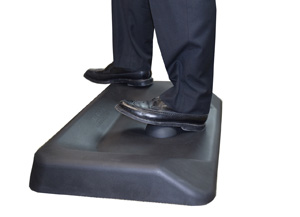
Standing desk mat (also called an anti-fatigue floor mat). A way to aid changes in how one stands is to have a contoured-surface floor mat that provides easy ways to shift from the left leg to the right and back to left again. This particular active standing desk mat allows wide and narrow stances and calf stretches and has a ball-like feature for a type of foot massage.
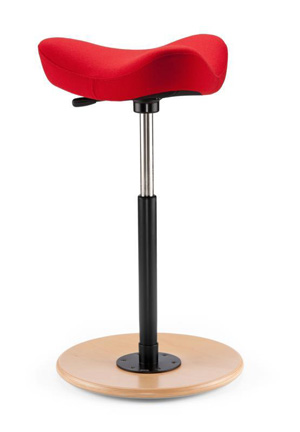
An adjustable standing desk chair (also called a tall desk or sit-stand chair). Ideally, you’re moving your body around in all kinds of ways and this type of chair adjusts to it. Sometimes it’s useful to “perch,” meaning half-standing with the tailbone rested onto the front of the seat. Otherwise, you can alternate between a full sit and full stand and all points in between.
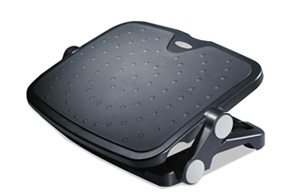
A desk footrest. An ergonomic footrest under the desk can work for those who sit as well as standers. A tilt mechanism further allows foot and ankle flexion.
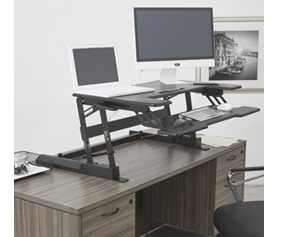
A standing desk converter. Suitable for the home-based office, this is an adjustable desk riser that simply is placed on top of an existing desk. With a 24” depth and 36” width, it is an affordable means of converting an existing (traditional) desk.
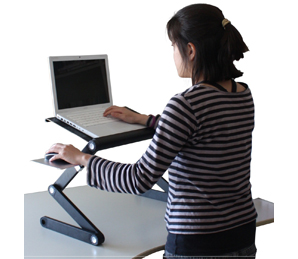
Laptop risers (e.g., a laptop holder for the desk). This is the simplest model of a sit-stand desk that is height, depth and angle adjustable. It supports a laptop computer alone at varying heights, which allows the user to shift easily from sitting to standing, plus its small folded-down size (4.4 pounds, 22”x11”x2”) makes it possible to travel with this device.
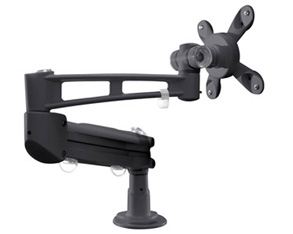
Monitor arms. A variation on the laptop riser is a monitor arm for desktop computers.
To the point of variety in working positions, the International WELL Building Institute also awards certification points to companies that provide pairs of fixed-height desks in standing and seated heights (ergonomic chairs accompanying the lower-height desks). This is a nod to the fact that moving around, providing the variety to the musculoskeletal and cardiovascular systems, is preferred over any type of prolonged stagnation.
If you have any questions about ergonomic products or need help with home office setup, feel free to give us a call at 888-404-2136 or use our contact page.
